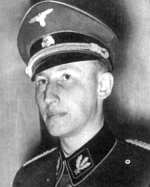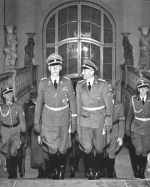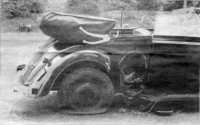 |
| Heydrich |
Reinhard Heydrich was born on
7 March 1904 in the German town
Halle, and baptized
Reinhardt Eugen Tristan. It was his given name of "Reinhardt" that
would become synonymous (besides
Auschwitz) with the deportation, mass shooting
and systematic slaughter of European Jews and Romanies in
Belzec,
Sobibor,
Treblinka, and
Majdanek.
The Heydrich family was one of culture and piety. His father,
Bruno Richard Heydrich,
an exceptionally gifted musician, founded the
Halle Conservatory of Music and young
Reinhardt was trained as a violinist, a skill that remained with him throughout his lifetime.
The Heydrichs were devoutly catholic yet despite the Protestant majority in
Halle. They maintained an upper class lifestyle enjoying privileged status
among the community. Heydrich attended the best schools and excelled in academics.
Fiercely self-driven he also displayed natural athletic ability, especially in the art of fencing for which
he received several awards; in his later years he would also become an accomplished pilot.
As a teen he was plagued by rumours of Jewish ancestry that allegedly stemmed from his fathers bloodline. These
rumours continued on through his adult life resulting in an
investigation ordered by
Gregor Strasser
in
1932, at the instigation of
Rudolf Jordan,
the
Gauleiter of
Halle-Merseburg. A report was submitted to the
information office of the
NSDAP center in
München (Munich). However, it
dealt only with the parental line, since
Jordan's suspicions were based primarily on
the fact that the father,
Bruno Heydrich, was described in Riemann's musical
encyclopedia of
1916 as "
Heydrich, Bruno, real name
Süss". The report came to the conclusion that the
name "
Süss" was not incriminating and that
Bruno Heydrich's son was free from any "Jewish blood".
There have been theories of Jewish ancestry also originating on his mother’s side but no conclusive evidence
supporting these theories has thus surfaced.
Martin Bormann's personal file
on Heydrich, which included his family tree, has been preserved. This family tree goes back only one generation
on his mother's side and omits the name, parentage and place of origin of his grandmother. Anyway Heydrich
changed his first name into "Reinhard" and tried to avoid writing his name with a "t" when he started his
career as a major SS-officer.
At the age of 16 Heydrich took up with the local
Freikorps and became strongly influenced by the racial
fanaticism of the German Volk movement and their violent anti-Semitic beliefs. Two years later he left
Halle to pursue a Naval career as a signals officer, and by
1926 he had risen to the rank of second lieutenant in the Baltic Command of the German
Navy (
Admiralstabsleitung der Marinestation Ostsee).
It was here that he first made contact with Admiral
Wilhelm Canaris of the German
Military Intelligence. The two became close friends, but later bitter rivals.
Heydrich’s dreams of becoming an admiral in the German Navy were cut short in
1931 when he, well over six feet tall, blonde haired and blue-eyed, had taken to
womanizing. While engaged to
Lina von Osten (whom he later married in
1931), he was accused of having sexual relations with the unmarried daughter of a local
shipyard director. It was claimed she became pregnant as a result of the affair but Heydrich refused to
marry her. A scandal ensued and he was subsequently forced to resign his commission on the orders of Admiral
Raeder, due to charges of "conduct unbecoming and officer and a gentlemen".
 |
Heydrich and his Son
Klaus in Monaco |
Out of work and with few options open he joined the Nazi party with the number of 544,916. In
1931, at the age of 27, he became a member of the SS, registration number 10,120. It wasn’t
long before his Aryan looks and strict attention to detail caught the eye of the
Reichsführer-SS
Heinrich Himmler, with whom he managed to secure an interview for the role
of SD Chief.
The SD (
Sicherheitsdienst) was to be the new intelligence service for the SS and
Himmler was looking for the right man to run it. The interview took place
on
14 June 1934, and lasted twenty minutes. Legend has it the interview itself consisted
of only a single
question put forth by
Himmler: How an Intelligence organization should
be structured? Heydrich responded quickly and decisively. He called on his
experience as a Naval Signals Officer and his passion for British spy novels. Armed with this pool of knowledge
both factual as well as fictional, he provided an outline that met with an enthusiastic
Himmler’s immediate approval. Heydrich’s
star was on the rise.
Heydrich grew the SD from a single room non-entity to an organization controlling
a national network of informants. He collected information and created files on Communists, Trade Unions, Social
Democrats, wealthy industrialists, Jews, even Nazi party members and SA leaders.
In
1933, Heydrich, then
SS-Oberführer, became first Chief of the
Political Department of the
München Police, later Chief of the Bavarian
Police, and in
1935 Chief of the whole German Security Police (incorporating
Gestapo
and SD).
Together with
Himmler and
Göring, he
plotted the downfall of SA (SA =
Sturmabteilung) leader
Ernst Röhm
in what became known as the "Night of the Long Knives". Scores of SA leaders were arrested and murdered thus ending
the power of the SA and forever keeping the brown-shirts (SA uniform) in the shadow of the black SS uniform.
Heydrich earned a reputation as ruthlessly efficient killer.
Gestapo tactics
of indiscriminate arrest, torture, intimidation, extortion and blackmail made him many enemies within the
Third
Reich as well as abroad. "
Nacht und Nebel" (night and fog), the right to seize "persons
endangering German security", who were not to be executed immediately but were to vanish without a trace, although
not officially decreed until
7 December 1941 was in practice by Heydrich and his
SD long before then.
Heydrich’s schemes also helped to guide his meteoric rise to power. Requiring
little prompting from
Himmler, he took the offensive against anyone deemed
in opposition to the SS, both real and assumed. Among those who met their political demise as a direct result
of his intrigues were War Minister Field Marshall
Werner von Blomberg, and
General
Werner Freiherr von Fritsch. When
Hitler needed a pretense to invade Poland he turned to the master of intrigue
and Heydrich delivered.
Hitler promised
the allies that he didn’t seek more territory in Europe. He needed an excuse; it came to him in the form of a
phony attack by Polish soldiers on a German radio station in
Gliwice (Gleiwitz).
Heydrich engineered the entire plot. He had SD-men, lead by
Alfred Naujocks,
dressed in Polish uniforms to stage an attack on the station.
They used bodies of murdered prisoners from KZ
Sachsenhausen which the SS referred to as "canned goods"
to appear as casualties. Radio Cologne announced that German police was repelling the attackers at
Gliwice (Gleiwitz). The
BBC also broadcasted a statement, which read:
"
There have been reports of an attack on the Radio Station
Gliwice, which is just across the Polish border
in Silesia. The German News Agency reports that the attack came at about 8.00 p.m. this evening when the Poles
forced their way into the studio and began broadcasting a statement in Polish. Within quarter of an hour,
says reports, the Poles were overpowered by German police, who opened fire on them. Several of the Poles were
reported killed, but the numbers are not yet known."
Hitler feigned outrage and used the incident as a pretext for invasion.
On
1 September 1939, German troops invaded Poland, the beginning of WW2.
Later that year Heydrich expanded the SD’s role to international espionage
and kidnapping in what became known as the
Venlo Affair. His agents succeeded in convincing British agents of
a plot by the General staff to overthrow
Hitler. The incident concluded with
two British agents being kidnapped at the Dutch border and brought to Germany as spies.
Heydrich managed to further exploit the incident when he led
Hitler to believe
there is a connection between the British agents and an assassination attempt on his life at a beer hall in
München.
 |
| Heydrich in Himmler's Office |
With the invasion of Poland Heydrich was then tasked with the strengthening
of German ethnicity in the occupied territory. To this end he created the
Einsatzgruppen (Special Action
Groups). They served as mobile killing squads to eliminate anyone who appeared to be a political threat to
the regime: communists, intelligentsia, political dissidents, Polish government officials who did not line up
with the invaders. There are little questions that a significant number of Jews were in the list of victims.
However, the apparent purpose, initially, was political.
Heydrich mandated in a document, dated
21 September 1939:
"
To the Chiefs of all Einsatzgruppen of the Security Police. Subject: Jewish Question in
the Occupied Territory.
I refer to the conference held in Berlin today, and again point out that the planned
total measures (i.e. the final aim) are to be kept strictly secret.
Distinction must be made between:
1. The final aim (which will require extended periods of time) and the stages leading to the
fulfillment of this final aim (which will be carried out in short periods). It is obvious that the tasks ahead
cannot be laid down from here in full detail. The instructions and directives below must serve also for the
purpose of urging chiefs of the Einsatzgruppen to give practical consideration to (the problems involved).
2. For the time being, the first prerequisite for the final aim is the concentration of the
Jews from the countryside into the larger cities."
On
27 September 1939, the
Reichssicherheitshauptamt (RSHA) was established,
Heydrich became its chief.
"
Unternehmen Barbarossa", the invasion of the Soviet Union, began on
22 June 1941.
This dramatically changed the
scope of
Einsatzgruppen activity with the addition of millions more Jews throughout the German sphere of
influence. The plan now moved from one of forced deportations and concentration of Jews to ghettos throughout
the
Generalgouvernement and
Warthegau regions, to one with a more sinister and final conclusion.
In
July 1941,
Reichsmarschall Hermann Göring
officially charged Heydrich with the overall concept, organization, and material arrangements to execute the
"
Final Solution". This was the very first time the term "Final Solution"
was used in an order for the systematic mass murder of every single Jew that could be found on the European continent.
Heydrich himself with his
Judenreferent (official in charge for Jewish affairs)
Adolf Eichmann chaired the famed
Wannsee Conference in
Berlin.
Eichmann acted as secretary.
Copies of the minutes still exist and were used at
Eichmann's trial in
Jerusalem in
1961-62. Most notable in the details of the
conference were the following statements:
Jews will be taken east, separated by sex, those capable will work, those not will fall away through
natural reduction. Death by the hands of the German's would now be unifying all resources towards an orderly,
efficient, coordinated and mechanical process for destroying the Jews... All to be carried out under the auspices
of Eichmann.
It is said Heydrich himself designed the system and planned much of the apparatus that would be used in the death
camps, but he himself wouldn’t live long enough to see his plan come to total "fruition".
 |
| Heydrich in Prague |
Late in
1941,
Hitler appointed Heydrich as
Reichsprotektor of Bohemia and Moravia" encompassing much of what is now the Czech Republic.
Himmler approved of this appointment as he himself feared
Heydrich’s ambition. Safer to have him outside of
Berlin; with less direct
access to
Hitler. Replacing Baron
Konstantin von
Neurath whom
Hitler viewed as too lenient. Heydrich together with his
subordinate
Karl Hermann Frank wasted no time in demonstrating to the Czech
people just whom their masters really were. Within weeks of his appointment he ordered the hanging of 200 Czech civilians.
He outlawed all Czech cultural groups, began the immediate deportation of Jews to Poland and ordered the
Gestapo
to increase arrests and executions.
Throughout his reign in the "protectorate" Heydrich deemed himself a patron of the arts, commissioning opera's and
sponsoring orchestral performances in
Praha (Prague), which he viewed as
becoming the next great cultural center in Europe. Meanwhile he still managed to find time to order the
deportation of Jews from
Terezin (Theresienstadt) to killing centers in
Riga, the transport of Jews from the
Lodz Ghetto to their deaths in the
gas vans of
Chelmno, while also reviewing progress reports of experimental
killing techniques being conducted at the newly completed death camp at
Belzec.
 |
| Investigations 1 Day later |
 |
| His damaged Car |
Back in
Praha, his method of Carrot and Stick had the desired effect
on the population
and now seen as a primary target by the Czech government in exile, it was decided that he had to go. Czech assassins
Jan Kubis and
Josef Gabcik were trained
by British commandos and dropped by parachute into the Bohemian countryside. There they made contact with the
local resistance and on
27 May 1942, at approximately 10:30 a.m.,
Jan Kubis and his comrades mounted an attack on
Heydrich's car. As his
comrade’s STEN gun failed to fire,
Jan Kubis hurled a grenade which exploded
against the rear wheel well of the car. Both assassins escaped the scene of the attack although
Kubis was slightly wounded. Heavily injured
Heydrich died ten days later due to infection in his spleen caused by wounds
sustained in the attack. He left behind a
wife and four children.
Himmler ordered a full scale round up and investigation.
Praha was effectively
sealed until all conspirators were captured. The
Gestapo offered 10,000,000 Kronen (crowns) for information
leading to the arrest of the assassins. Eventually the parachutists were betrayed by two of their own team.
Kubis and
Gabcik took refuge at the
Church of St Cyril and Methodius (Karel Boromejsky) on
Resslova Street in
Praha. Nazis learned of he hideout and
on
18 June 1942 SS-troops surrounded the church. Trapped in the
crypt parachutists fought until dawn, and in
the following morning in a final act of defiance they committed suicide.
Typical with Nazi "Modus Operandi" reprisals were swift. The entire village of
Lidice, with a suspected connection to
Jan Kubis, was razed to the ground on
Hitler’s
orders. All male inhabitants were shot, and the women and children sent to concentration camps.
With Heydrich’s death the SS went into mourning. At his funeral both
Hitler and
Himmler eulogized him with great praise. He was to have a monumental tomb at
the Invaliden cemetery in
Berlin but the construction failed to commence
as the war took higher priority over memorials.
Heydrich didn’t live to see the mass murder of Jews fully implemented, but the Nazis had gotten this (his) plan
already on the way: The death camps
Belzec and
Sobibor were already "in action", and
Treblinka was in the planning stage.
Until today nobody knows who came up with the term "
Einsatz Reinhard(t)" or "
Aktion Reinhard(t)" but
it can be assumed that this term for the Holocaust in the
Generalgouvernement and the
Bialystok area was invented in memory of its chief planner Heydrich. A certain thought
of revenge must have been implied. Similar to this is the marking "AaH" ("
Attentat auf Heydrich" /
assassination on Heydrich) for the deportation train from
Praha which left the
town on
10 June 1942, carrying 1,000 Jews to the East. Most probably this train arrived at
Majdanek (on
12 June) where around 100 persons were
selected for work. After another horrible day it arrived at its final destination, the
Sobibor death camp.
The
Aktion Reinhard chief architect had gone, and those who succeeded him carried out his plans with zeal
and efficiency, leaving millions of murdered Jewish men, women and children behind them.
Sources:
MacDonald, Callum:
The Killing of Reinhard Heydrich
Richard Breitman:
Holocaust and Genocide Studies Volume 11
G. S. Graber:
The Life and Times of Reinhard Heydrich
Ulric of England:
Reinhard Heydrich Memorial Book
Cowdery and Vodenka:
Reinhard Heydrich Assassination USM Incorporated, 1994
Gerald Reitlinger:
The Final Solution Vallentine, Mitchell and Co ltd., 1953
© ARC 2004












